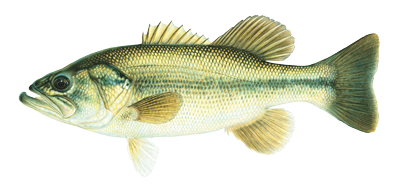
Largemouth Bass
Micropterus salmoides
This robust fish is the largest member of the sunfish family in Ontario. They average in size from 2lbs to 5 lbs with the Ontario record being 14.75 lbs. Their colouration tends to be olive green with a white belly and a distinctive black lateral band in younger fish. This black band tends to disappear in older fish. The most consistent distinguishing features between largemouth bass and smallmouth bass is the position of the mouth in relation to the eye. If the back edge of the mouth extends past the back edge of the eye, it’s a largemouth bass. If the mouth only extends to the middle of the eye, it’s a smallmouth bass.
Largemouth bass are distributed throughout Ontario but are most common in southern and eastern Ontario. They prefer shallow, weedy lakes and bays and are rarely found in water over 7 metres deep. Young smallmouth bass prey on a range of aquatic insects, invertebrates, and small fish. They are known to be cannibalistic and it has been reported that as much as 10% of the prey eaten by bass over 203mm is fry of their own species. Adults primarily prey on fish; however frogs, mice, snakes or anything else it can fit into its mouth will fall victim to a largemouth bass’ voracious appetite. Sexual maturity is usually reached by their 3rd to 4th in males and 4th to 5th year in females. The maximum lifespan in Canada is about 15 years.
Spawning takes place in the late spring day period when water temperatures have reached 16 to 18 degrees C. In areas containing both smallmouth and largemouth bass, the largemouth bass tend to spawn first. Males construct nests on a marl or mud bottoms in association with aquatic vegetation such as bulrush and water lilies. Nests are usually in shallow water up to 1.2 metre deep with males aggressively defending their territory against other males. Females pair up with the males and after considerable pre-spawn courtship, eggs are laid in the nest. Females’ average between 2000 and 7000 eggs per pound of body weight and may spawn with more than one male. Males aggressively guard the nest until the eggs hatch (3 to 5 days) and continue to guard the young fry for about 4 weeks. Growth of the young bass is rapid, depending on the availability of invertebrates and water temperatures.
Largemouth bass will readily adapt to pond environments and have been stocked extensively throughout Canada. Perhaps their most attractive attribute is their tolerance of warm water which would be lethal to many other species of game fish. Ponds and lakes with a large forage base can easily produce a number of bass in the 3 to 5 pound range. They provide great sport and are also excellent on the table.

